With the NFL Draft in the books, we like to go back and better familiarize ourselves with some of the prospects the Detroit Lions added to the roster through their college tape. We’re going to kickstart our annual film reviews with former Alabama running back Jahmyr Gibbs.
▶ Games watched: @Texas (Sept. 10), @Arkansas (Oct. 1), vs. Texas A&M (Oct. 8), @Tennessee (Oct. 15), @LSU (Nov. 5), vs. Kansas State (Dec. 31)
▶ Statistics: 2020 (Georgia Tech): Seven games, 89 carries, 460 yards (5.2 average), 24 receptions, 303 yards, seven touchdowns from scrimmage, 25.6-yard kickoff return average.
2021 (Georgia Tech): 12 games, 143 carries, 746 yards (5.2 avearge), 35 receptions, 465 yards, six touchdowns from scrimmage, 25.6-yard kickoff return average, one touchdown.
2022 (Alabama): 12 games, 151 carries, 926 yards (6.1 average), 44 receptions, 444 yards, 10 touchdowns from scrimmage, 19.8-yard kickoff return average.
▶ Durability: Gibbs missed the final three games of his freshman season at Georgia Tech with a leg injury, before appearing in all 12 contests the following season. At Alabama, he suffered minor ankle and shoulder injuries. He played through the shoulder issue, but was held out of a late-season, nonconference matchup against Austin Peay to allow the ankle to properly heal.
▶ Athletic profile: Gibbs opted not to participate in many of the athletic testing drills this offseason, only doing the 40-yard dash and the vertical jump. He posted an average result in the leap (33.5 inches), but showcased elite speed with a 4.36-second time in the 40, with an equally impressive 1.51-second 10-yard split.
For comparison, former Lions running back D’Andre Swift ran the 40 in 4.48 seconds, while Gibbs’ time is equal to the one posted by Jahvid Best, when he was coming out of Cal.
▶ Usage: Obviously, as a running back, Gibbs primarily lined up in the backfield for the Crimson Tide. But they also frequently moved him around, putting him in the slot or as an outside receiver on 87 of his 462 snaps (18.8%) last season.
▶ Vision: Gibbs sees the field well and is able to anticipate defenders both at the line of scrimmage and in the second level. His bread-and-butter play is the stretch zone, where he can angle outside into space, allowing his blocking to set up, then finding the best lane to get up field. He was able to do this consistently, with success, throughout the 2022 season.
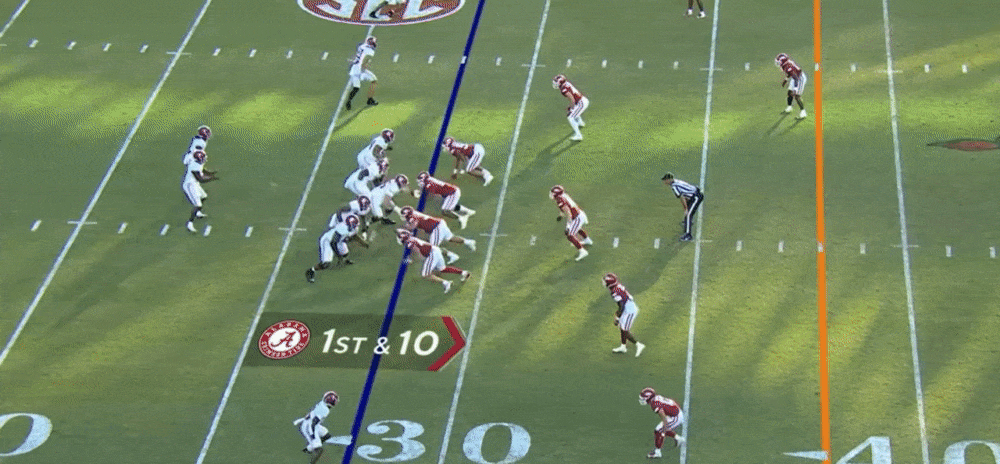
Once in the second level, he’s able to identify the linebacker and safety, get them leaning and avoid contact to gain extra yardage at the end of his runs, resulting in many of his longest gains last season.
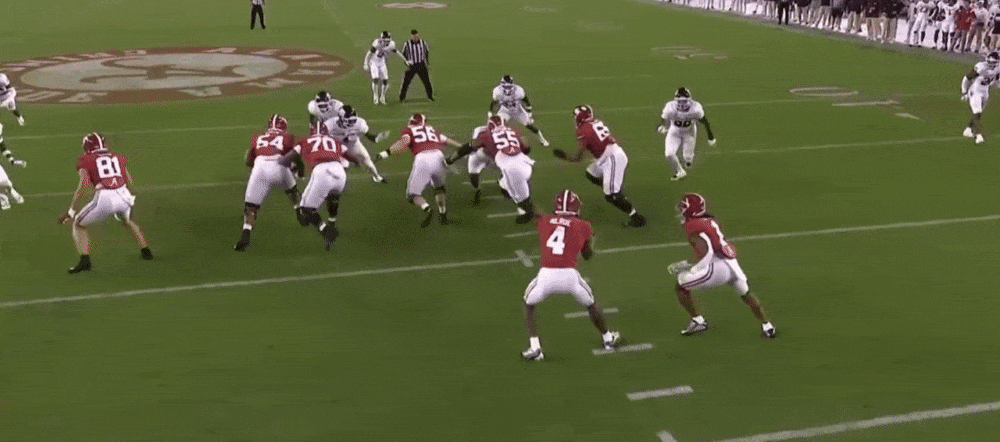
▶ Balance/power: Although I’ve traditionally lumped these together when evaluating running backs in the past, it might have been best to separate them looking at Gibbs.
The balance is noticeable and impressive. He’s able to maintain a low center of gravity, bouncing off defenders who fail to wrap up.

The power is subpar, but not from a lack of effort. Gibbs keeps his legs churning in a crowd, but is rarely able to power through a fundamentally sound tackle attempt. He’s at his least successful when asked to run up the middle, through the A and B gaps, almost never gaining more than what’s blocked for him.
Gibbs often will attempt to utilize a stiff arm, but his length (30½-inch arms) limits its effectiveness.
▶ Burst: Easily the most recognizable trait from Gibbs’ tape is his ability to turn on the jets, going from 0-60 in the blink of an eye. When he sees a seam, he hits the hole in a hurry.
Gibbs’ burst also shows up in space, one-on-one against a defender. He goes from level to having a step in a few strides, often besting linebackers, defensive ends and safeties to the perimeter. The fact he’s able to do this against SEC-level competition suggests it should port to the next level.

▶ Patience: Early in the season, against Texas, it felt like Gibbs’ was pressing into his line and taking away his ability to cut and utilize his speed. That could have been a symptom of him getting to know the offense and his blocking or Alabama still gaining a grasp on how to best utilize him in their scheme after bringing Gibbs in through the transfer portal during the offseason.
By midseason, the stretch zone was being more regularly utilized and Gibbs demonstrated consistent patience, allowing his blocks to set up. That trait carried over to other types of runs, from following a fullback to pulling offensive linemen.
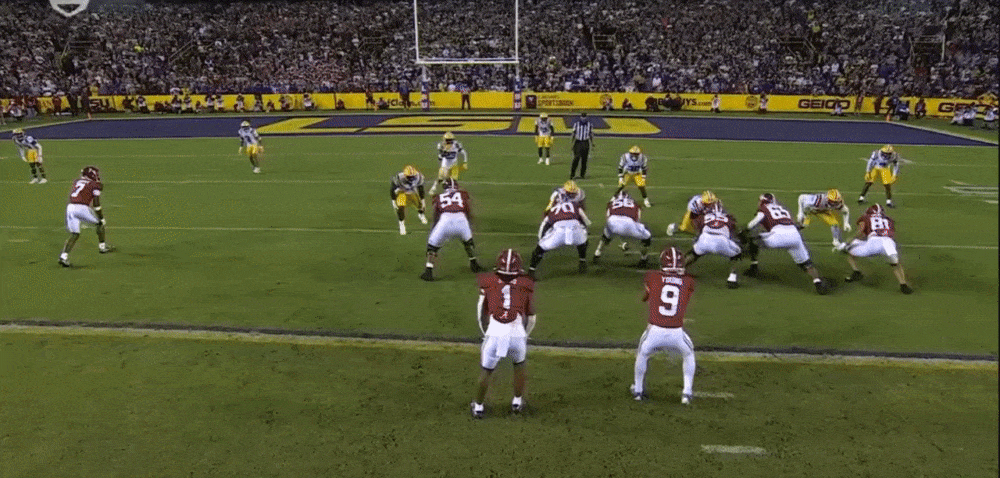
▶ Elusiveness: Hitting on it earlier, Gibbs is difficult to bring down when shifting into high gear in the second level. He has an outstanding sense of leverage with defenders in those moments, giving them fits as they try to square him up in the open field.
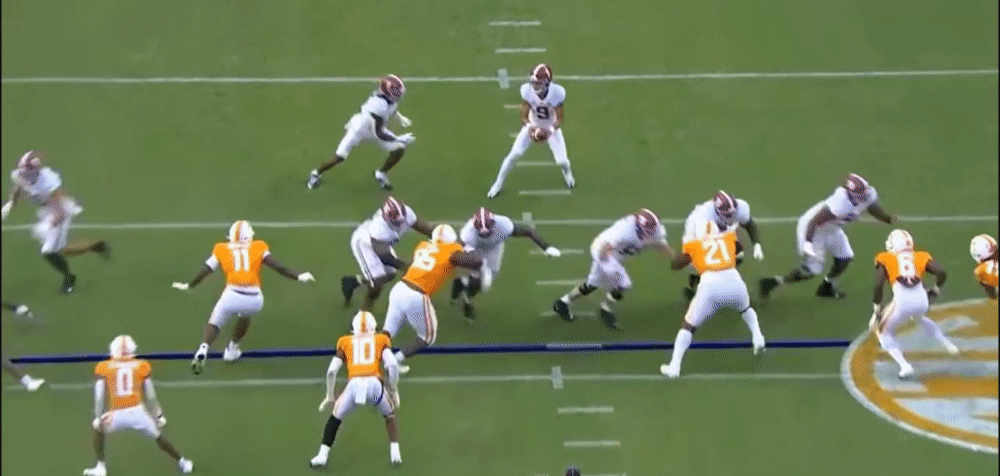
Also going back to a point made earlier, the speedy back will get the corner on any defender who doesn’t have a perfect pursuit angle, and in some cases, even that’s not enough to track him down.
▶ Play speed: We know that a 40-yard dash isn’t always reflective of what shows up on film, but Gibbs’ 4.36 speed (99% percentile) is clear on his tape, as is his 1.51-second, 10-yard split (97% perctile), which shows up through his rapid acceleration.
▶ Ball security: Gibbs fumbled four times during his college career, but had zero his final 17 games. None of his fumbles resulted in a traditional turnover, although one came on fourth down. He recovered two and teammates recovered the other two.
▶ Receiving skills: As noted, Gibbs lined up all over the formation for the Tide, including receiver alignments nearly one-fifth of the time. His route tree wasn’t complex from any spot, counting out of the backfield, but what he does, he does well.
When working out of the backfield, Gibbs’ most common routes were swing and shoot patterns, which would get him in space on the perimeter. He also ran a lot of angle routes, cutting back inside, often with a sharper vertical stem than I’m accustomed to seeing run by the Lions, which allowed Gibbs to have momentum going upfield as the ball arrived, increasing the chances of a big play.
From the outside, most of Gibbs’ routes were short hitches against zone and off-man coverage. He also would occasionally go in motion from an outside alignment and take a tap pass, allowing the ball to get into his hands while at top speed.
Against Kansas State in last year’s bowl game, he smoked the linebacker with a crisp release on a shallow cross, turning the route into a sizeable gain.
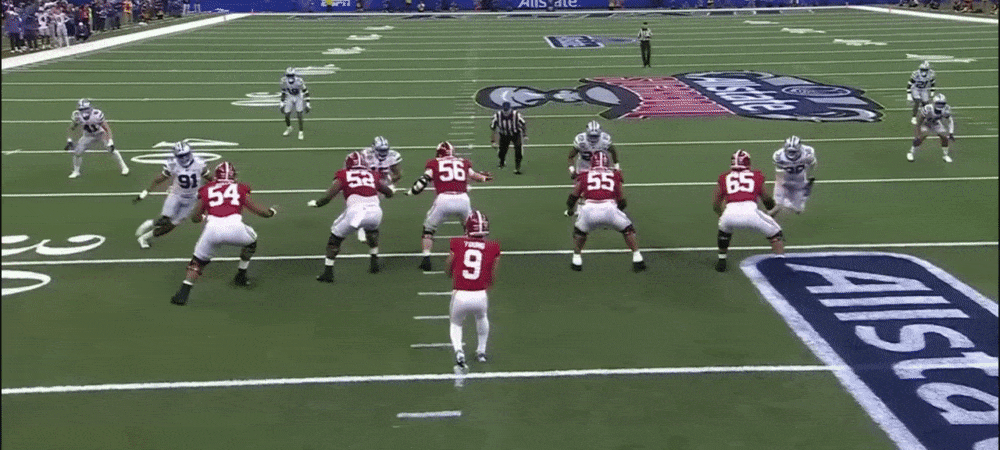
One of the most impressive aspects of his receiving skillset is his advanced ability to find space in a scramble drill setting. When the pocket breaks down, Gibbs doesn’t quit on the play, instead looking to be an additionally outlet for his QB. He did this while lining up outside in the closing minutes against Texas, hauling in a go-ahead touchdown.
Overall, Gibbs’ has well-above-average hands, with his lone drop of the season coming against Tennessee. He bobbled another one, but managed to haul it in during the six games we viewed. His arm length does require accurate ball placement and could limit his downfield potential.
▶ Blocking: Against Texas, Gibbs didn’t appear to have a solid grasp on his blocking responsibilities, twice missing his assignment, resulting in a sack.
As the season progressed, he got better. There’s no concerns about his willingness, but with his frame, there’s always going to be an element of being overmatched by oncoming linebackers.
▶ Conclusion: This admittedly might sound like confirmation bias, but I went into the study looking to compare what Gibbs did at Alabama to the way the Lions used D’Andre Swift when he was healthy, and there was significant overlap.
Like Swift, Gibbs is better when working toward the outside with his handoffs, has a good sense for his blocking and which lanes to take. Both also offer plenty in the pass game, but Gibbs looks to be the better route runner, particularly with that eye-opening release off the line working from the slot against Kansas State. It’s the type of footwork that can win against a nickel cornerback, which is a rare ability for a running back. The way Gibbs worked the angle route brought back visions of another Lions running back, Theo Riddick. Gibbs even uses the same dead-leg move to set up his break and create separation.
Alabama worked exclusively out of the shotgun, and Georgia Tech was primarily in the gun, too, so Gibbs was often taking handoffs from a standstill, or after a single lateral stride. He’ll likely benefit from having the opportunity to get his momentum going toward the line from Detroit’s under-center looks.
Running Gibbs inside should be kept at a minimum, both because it’s a waste of his best skills and it will help keep him on the field. That said, he’s apt to do some damage with an occasional draw play, once again, similar to Swift.
Gibbs didn’t look great returning kicks for Alabama, but didn’t get many opportunities and didn’t benefit from quality blocking. His kickoff return tape from Georgia Tech is much more intriguing, but it would be understandable if the Lions shied away from putting such a valuable asset in that spot.
jdrogers@detroitnews.com
Twitter: @Justin_Rogers